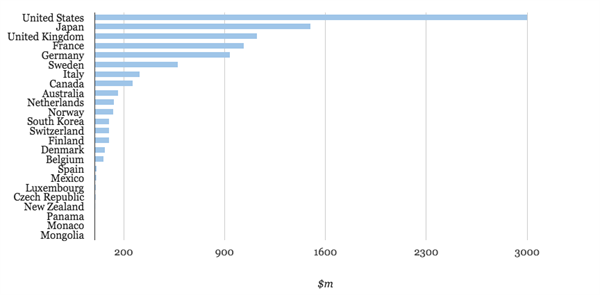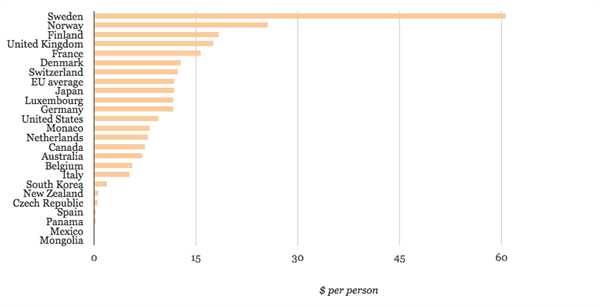Mat Hope
10.12.2014 | 10:00amCountries have pledged a little over $10 billion to the UN’s climate adaptation fund. Contributions to the Green Climate Fund (GCF) are seen as a vital step towards countries agreeing a new global climate deal in Paris next year.
Here’s our guide to the fund, the pledges, and the conditions attached to the contributions.
The Green Climate Fund
The GCF was established at the Copenhagen climate summit in 2009 with the aim of channeling money to help developing countries implement climate policies. But it has been struggling for funds.
When the fund is fully operational, world leaders have committed to contributing $100 billion a year. That should happen by 2020.
The GCF organised a pledging conference on November 20th. It gave countries a platform to announce their contributions to the fund’s ‘initial resource mobilisation period’, that runs for three years between 2015 and 2018. The GCF had originally aimed to get countries to pledge $15 billion in seed funding by the end of this year, but it lowered the target to $10 billion in September.
Pledges from the conference fell just short of that goal, totalling $9.3 billion. Many of the pledges were made in countries’ national currencies, meaning the overall value alters depending on the exchange rate.
Of the money channeled through the GCF, half will go to funding adaptation measures in developing countries, such as better flood defences, drought monitoring schemes, and water management systems. And at least half of those funds will go to countries that are most at risk from the impacts of climate change.
The other half of the GCF’s money will go towards helping developing countries curb their emissions, by decarbonising their energy and transport infrastructure.
The GCF is politically important. It is the most high profile mechanism that allows developed countries to transfer climate-linked money to more vulnerable states. Many of the nations who will be beneficiaries of the fund have said they can’t commit to cutting emissions unless developed economies honor their promises to contribute to the fund.
Here’s a quick outline of which countries have offered what, and the conditions attached to the pledges:

Countries often make pledges in their national currency, making the overall sum of contrinutions sensitive to the international exchange rate. The GCF estimates that contributions so far are worth $10.14 billion.
UK
The UK has pledged to fund 12 per cent of the GCF up to £720 million, or about $1.1 billion, over three years. It has pledged the most of any European nation.
Earlier this week, prime minister David Cameron told journalists the pledge was not “new money”, and would come out of the UK’s existing climate aid budget. That means the pledge contributes towards the UK’s commitment to use 0.7 per cent of its gross national income for overseas development assistance.
However, the government has been reluctant to discuss the details of the contribution. This reluctance has been linked to the politicisation of climate aid in the UK. Earlier this week the Daily Mail ran an article claiming some Tory MPs were “furious” the prime minister was giving funds to “Third World flood defences”.
The pledge comes the same day as the Rochester by-election, in which the right-wing UK Independence Party (UKIP) is expected to win at the Conservatives’ expense. UKIP is staunchly climate skeptic.
US
The US has pledged $3 billion over four years.
The New York Times says it is “unclear” whether the funds would be drawn from existing or new sources. If the president wants additional funds, he will have to ask Congress. But the Senate’s new Republican leadership has made it a priority to roll back Obama’s climate action plan, and would almost certainly block any requests for extra financial aid to fund climate efforts.
If a Republican wins next year’s presidential election, they would also have the power to override the pledge. So whether the US will deliver the money is far from certain.
Germany
Germany has pledged â?¬750 million or “around $1 billion” to the GCF.
Germany was one of the first countries to announce its pledge. Germany hoped that by announcing early, it could set a high benchmark for other countries contributions.
“In Germany we are accepting our responsibility”, Germany’s chancellor, Angela Merkel said when she announced the contribution last July.
France
France matched Germany’s pledge of $1 billion. The contribution will be spread over four years, starting in 2015, Reuters reports.
Like Germany, France announced its contribution in advance of the Berlin pledging conference. France’s president, Francois Hollande, made the pledge at UN secretary general Ban Ki-moon’s climate summit in New York in October. Speaking at the summit, Holland said, “We need to define a new economy for the world. You can’t fight climate change without development.”
South Korea
South Korea has pledged the most to the GCF out of the world’s smaller economies: $100 million.
Only half of that is new money. The country had already pledged around $50 million to get the fund up and running. It has an extra incentive to do so: The GCF is based in Songdo in South Korea.
Canada
Canada has pledged $265 million to the GCF. It made the announcement four days after the pledging conference in Berlin. Canada’s contribution is significant because the country has been seen as one of the main obstacles to agreeing a new global deal in 2015.
Australia saw Canada as an ally in a “coalition of the unwilling”, with both countries reluctant to sign up to ambitious emissions reduction targets. Canada’s contribution makes Australia’s failure to pledge to the GCF more notable.
It pulled out of the Kyoto protocol, the world’s only binding agreement to cut emissions, in 2011. The country was set to miss its Kyoto protocol target partly due to a boom in oil extraction from Alberta’s tar sands.
Australia
Australia pledged $166 million over four years at the international climate negotiations in Lima, Peru. Australia’s contribution will be taken from its existing foreign aid budget.
Australia was perhaps the most notable absence from the pledging conference in Berlin earlier in the year. The country’s climate skeptic prime minister Tony Abbott had previously said the country was already contributing to global efforts to tackle climate change through the country’s green bank and foreign aid.
Speaking at a press conference at a G20 meeting, which Australia hosted, he said:
“we are doing a very great deal and I suppose given what we are doing we don’t intend, at this time, to do more.”
It’s close neighbour New Zealand had already pledged $3 million to the GCF.
Others
Japan has offered to contribute the second largest amount to the GCF: $1.5 billion. Japan made the pledge one day after the US at last week’s G20 meeting in Australia.
Rounding off the European countries’ contributions: Denmark pledged $70 million, The Netherlands $125 million, the Czech Republic $5.5 million, Switzerland $100 million, Luxembourg $6.3 million, Spain $16.3 million, Italy $313 million, and Monaco $0.31 million. Belgium later pledged $64 million at the international talks in Lima.
In addition to Sweden’s contribution, scandinavian countries Norway and Finland pledged $33 million and$100 million, respectively. Norway’s pledge was $30 million more than it previously announced.
Poland said it would announce its pledge by the end of the year.
Mexico has pledged $10 million and Indonesia has pledged $0.25 million. Neither country was expected to pledge to the fund, but chose to do so voluntarily. Panama pledged $1 million, while Mongolia has pledged $0.05 million.
Fair shares
What counts as a ‘fair’ contribution is ultimately subjective.
Oxfam has calculated possible ways to divvy-up contributions to the GCF among nations, taking account of each country’s historical contribution to climate change and their current capacity to finance climate action.
Oxfam’s analysis looked at fair shares for the GCF’s earlier $15 million target. We’ve adjusted the figures for the GCF’s current $10 billion goal.
Oxfam’s analysis suggests the US, Germany, and France are all paying a fair amount, given their contributions to other international funds. The UK is paying about $500 million more than its fair share, according to Oxfam’s criteria. Sweden is the biggest outlier, pledging $500 million or four and half times what it’s fair share might be.
Thinktank E3G takes a different approach. It looks at how much each country is contributing per person.
Sweden’s pledge is by far the most generous in those terms, at around $60 per person. Sweden’s international development minister argues that pledges to the fund shouldn’t be seen as an expense, but an investment to secure a safer, more prosperous future for everyone.
Norway is the next most generous at a little over $25 a head. The US’s pledge works out at about $9.50 per person, while the UK’s is worth about $18.
The poorest countries that pledged to the GCF are giving the least, by this metric. Panama, Mexico and Mongolia all pledged the equivalent of less than $1 per person. Those countries were not expected to contribute to the fund at all, however.
Australia and Canada, perhaps the two countries most reluctant to give to the fund, have both pledged a bit over $7 per person.

Source: Data from E3G. Graph by Carbon Brief.
Each country will have taken a range of factors into account when working out how much to pledge, Oxfam previously told Carbon Brief: from how much of its existing budget can be channelled towards climate change efforts, to how much political will it has for a new global climate deal in 2015.
Adaptation funds
No-one is sure how much money will be needed to help countries adapt to the impacts of climate change in the long run.
That’s partly because it depends on how much countries emit in the coming years. The Intergovernmental Panel on Climate Change says that if countries take more action to curb emissions, the impacts of climate change and associated costs are likely to be lower in the future. That means there’s a wide range of estimates of how much may need to be spent in the future.
News service IRIN has rounded up some estimates: The UNFCCC estimates that by 2030 poor countries would need between $28 billion and $59 billion a year, the World Bank thinks between $20 billion and $100 billion a year, the European Commission estimates between $10 billion and $24 billion a year by 2020, and the African Group of climate change negotiators arrived at a sum of more than $67 billion a year by 2020.
Main image: UN climate change conference, Lima. Credit: UNClimateChange/Flickr.
Note: Oxfam UK has updated its fair shares analysis, which comes out with slightly different figures to Oxfam US's analysis quoted. Updated 23/11/2014: To include Canada's contribution and the per capita analysis. Updated 10/12/2014: To include Australia and Belgium's pledges.

